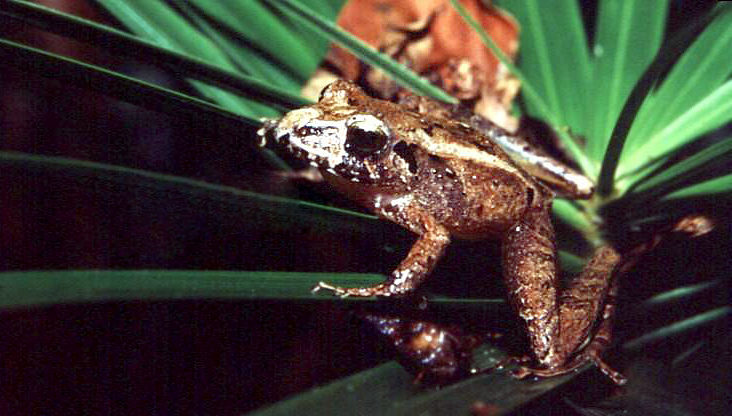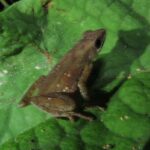- Ischnocnema guentheri: Brazil's Enigmatic Leaf-Litter Frog
- Taxonomy and Classification: Understanding the Identity of <em>Ischnocnema guentheri</em>
- Natural Habitat: Life Beneath the Leafy Canopy
- Physical Characteristics: Masters of Camouflage and Adaptation
- Behavior and Life Cycle: From Egg to Emerging Adult
- Ecological Role: A Guardian of Forest Health
- Threats and Conservation Status: Battling for Survival
- Cultural and Scientific Significance: Beyond Mere Survival
- Conclusion: Embracing Our Silent Guardians
Ischnocnema guentheri: Brazil’s Enigmatic Leaf-Litter Frog#
Deep in the misty, emerald cloaks of Brazil’s Atlantic Rainforest, hidden beneath layers of damp moss, decaying leaves, and tangled roots, dwells a small yet fascinating inhabitant—Ischnocnema guentheri. Known colloquially as Günther’s Robber Frog, this unassuming amphibian carries secrets of evolutionary success etched in its carefully adapted body, its melodious nighttime chorus, and its essential role as a guardian of environmental balance. Though often overlooked in favor of more charismatic fauna, a closer exploration into Ischnocnema guentheri reveals a compelling narrative woven through delicate ecosystems, symbiotic relationships, and the omnipresent threat of disappearing rainforests.
In this journey, we’ll delve deeply into the captivating life, intriguing habits, and ecological significance of Ischnocnema guentheri, highlighting why protecting these subtle heroes of biodiversity means protecting an entire world in miniature. Let’s step together beneath the lush canopy, lifting leaf after leaf, into the fascinating universe of Brazil’s enigmatic forest frog.
Taxonomy and Classification: Understanding the Identity of Ischnocnema guentheri#
Like every unique creature wandering our planet, Ischnocnema guentheri fits into a scientific classification system sharpening its biological identity. It belongs to the vast and diverse family Brachycephalidae, a group known for their distinct development patterns, often bypassing the tadpole stage. Positioned within the genus Ischnocnema, it shares lineage with a variety of forest-dwelling frogs notable for their terrestrial habits and unobtrusive presence.
Described scientifically by Steindachner in 1864, this frog’s species name, guentheri, honors zoologist Albert Günther, a celebrated 19th-century herpetologist whose studies illuminated amphibian biology. Today, thorough genetic analysis underscores its relationships closely intertwined with similar “leaf-litter frogs,” which are revered by amphibian researchers for their adaptability and resilience.
Natural Habitat: Life Beneath the Leafy Canopy#
A Jewel of Brazil’s Atlantic Rainforest#
Confined chiefly to Brazil’s Atlantic Forest biome, Ischnocnema guentheri thrives in areas characterized by perpetual moisture, dappled sunlight filtering through sprawling canopies, and deep-layered forest floors. This dense, humid setting—rich with mosses, ferns, orchids, and fungi—is not merely the backdrop for the species’ existence but a living testament to their evolutionary journey. From Minas Gerais to São Paulo and Rio de Janeiro, these forests hold an extensive history of isolation and biodiversity that has produced some truly extraordinary wildlife, including our humble amphibian subject.
A Terrestrial Adaptation#
The terrain most suited to Günther’s Robber Frog’s life is characterized by thick, moist leaf litter—an ideal hideaway protecting it from predators and weather extremes. It’s not a swimmer or arboreal climber by habit, but rather an adept camper of the forest understory, navigating the delicate world between soil and decomposing vegetation with practiced ease.
This specific habit of dwelling almost exclusively among fallen leaves reveals a unique ecological niche. By subtly assisting leaf breakdown, nutrient recycling, and pest population control, this frog contributes significantly to the forest’s intricate balance. Every movement, every feeding choice, every hidden resting place beneath decaying foliage magnifies its essential ecological role.
Physical Characteristics: Masters of Camouflage and Adaptation#
Esthetically speaking, Ischnocnema guentheri may initially appear unassuming. Most adult specimens span approximately 25 to 45 millimeters long—the perfect size to occupy leaf-litter depths discreetly. Encountering one, typically through careful patient searches beneath damp leaves, reveals greenery-tinted browns or rust-colored skin intricately patterned—an impeccable camouflage mirroring the forest floor.
The frog’s skin texture, subtly roughened, perfectly mimics the grainy feel of decomposing leaves. Large, expressive eyes shaded with coppery hues hint at the nocturnal lifestyle, optimized for hunting in dim forest understories. Its fingers end in slightly expanded discs, not typically for climbing as in tree frogs, but for maintaining stability when traversing uneven litter.
Subtle yet strategic adaptations abound—each attribute honed over millions of years, designed specifically to provide protection, stealth, and comfort in its moisture-laden habitat.
Behavior and Life Cycle: From Egg to Emerging Adult#
Observing this frog’s behaviors requires patience, timing, and an embrace of mystery—a fitting reflection of the Atlantic Rainforest ambiance. Nightfall signals an awakening as male frogs vocalize softly yet reverberantly, their calls mingling harmoniously with nocturnal orchestras of insects and distant creatures. Each male establishes his domain beneath well-sheltered vegetation, attracting females through melodic insistence.
Direct Development: A Remarkable Evolutionary Strategy#
Unlike many frogs famously undergoing metamorphosis through a free-swimming tadpole phase, Ischnocnema guentheri practices direct development. Females deposit eggs in concealed moist locations under leaves or logs, bypassing water-bound stages entirely. From these eggs emerge tiny froglets—fully formed miniature versions of their parents, independent and instantly adapted for terrestrial life.
This developmental strategy offers numerous evolutionary benefits: notably reduced vulnerability since tadpoles require aquatic environments often visited by predatory species. Direct development reduces exposure to these dangers, bolstering juvenile survival rates. Such evolutionary brilliance encapsulates nature’s infinite inventive wisdom.
Diet and Hunting Techniques#
Nighttime brings forth a squadron of active invertebrates, ideal prey for patient ambush predators like our frog. Using subdued stealth, keen eyesight, and accurate precision, it consumes ants, termites, small spiders, mites, beetles, and insect larvae, controlling forest arthropod populations and fulfilling its ecological directive as nightly guardian against pest proliferation.
Ecological Role: A Guardian of Forest Health#
Though diminutive, Ischnocnema guentheri‘s ecological contributions loom large. Deeply integrated within trophic cascades, it serves both predator and prey roles. Its diet controls insect populations, indirectly aiding ecosystem balance by moderating leaf damage caused by herbivorous invertebrates. Meanwhile, predators such as snakes, birds, and small mammals depend on the frog as a vital food source, perpetuating natural cycles of life within the forest understory.
Moreover, as an indicator species, any noticeable declines or ecological problems affecting Günther’s Robber Frog alert conservationists early to potential hidden dangers threatening larger communities.
Threats and Conservation Status: Battling for Survival#
A Forest Under Siege#
Tragically, habitat destruction looms greatest among threats faced. Agricultural expansion, logging, urban encroachment, and infrastructure developments have disrupted vast areas of the Atlantic Rainforest biome, dramatically fragmenting crucial habitats and endangering species persistence.
The International Union for Conservation of Nature (IUCN) currently classifies Ischnocnema guentheri as Least Concern, but this status offers no guarantee of permanent security. Continued deforestation, climate fluctuations, pollution, and invasive predators could rapidly shift this conservation scenario.
Protective Measures for Tomorrow#
Efforts like creating protected habitat reserves, restoration projects, and stringent anti-deforestation regulations provide promising steps toward safeguarding the species. Continued research, population monitoring, and community environmental education further strengthens conservation strategies that preserve not merely this one frog, but an entire ecosystem’s integrity.
Cultural and Scientific Significance: Beyond Mere Survival#
Though less prominently depicted culturally compared to brightly colored poison dart frogs, Ischnocnema guentheri still captivates researchers and naturalists. Its direct development phenomenon, adaptive versatility, and ecological contributions hold deep importance scientifically, particularly in studying amphibian evolution, climate sensitivity, and ecosystem mechanics.
Conclusion: Embracing Our Silent Guardians#
Exploring the world of Ischnocnema guentheri affirms the profound interconnectedness of ecosystems and the critical roles even the smallest, least conspicuous beings play. It reminds us that conservation efforts should look beyond famed charismatic wildlife, recognizing subtle dramas unfolding quietly beneath whispered leaves. As mindful stewards of our planet, let’s pledge ongoing commitment to protecting treasures like Günther’s Robber Frog, safeguarding not merely a species, but the incredible biodiversity intricately woven throughout Earth’s landscapes.











